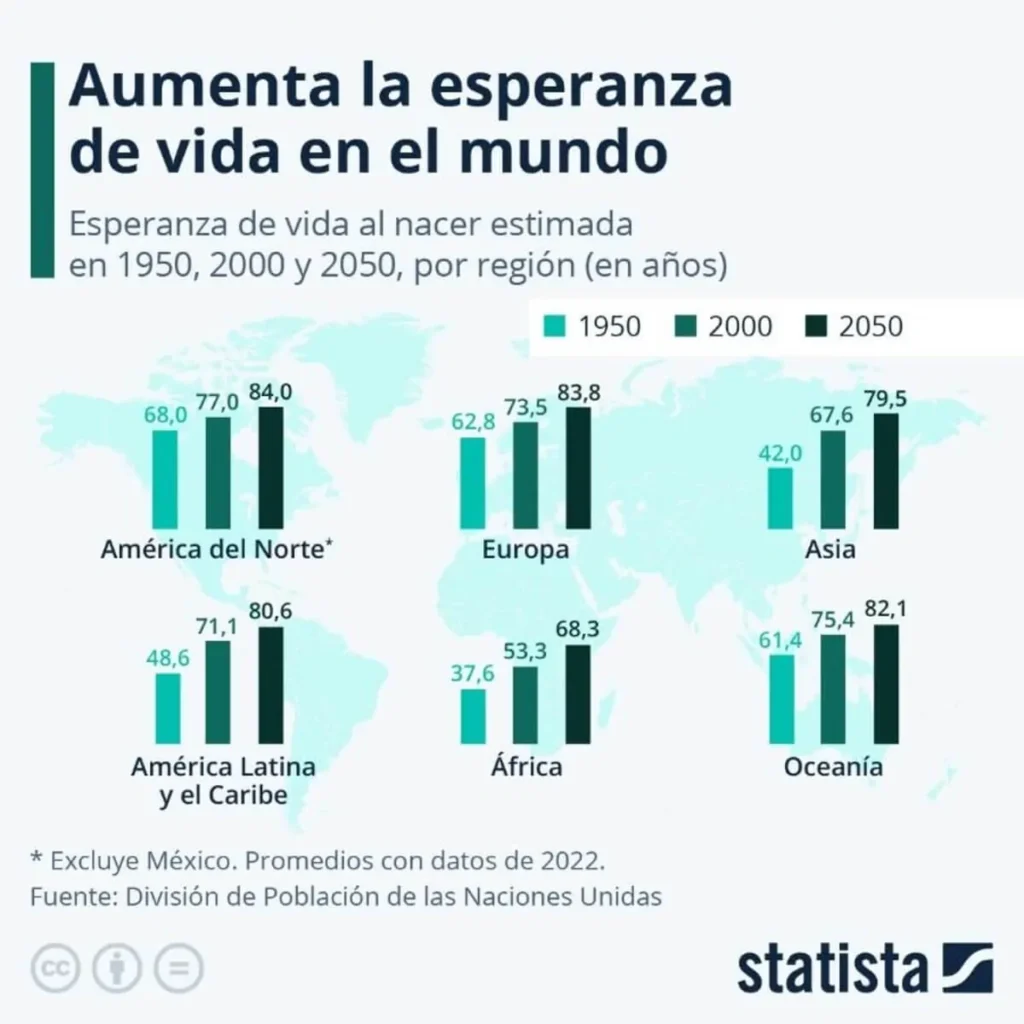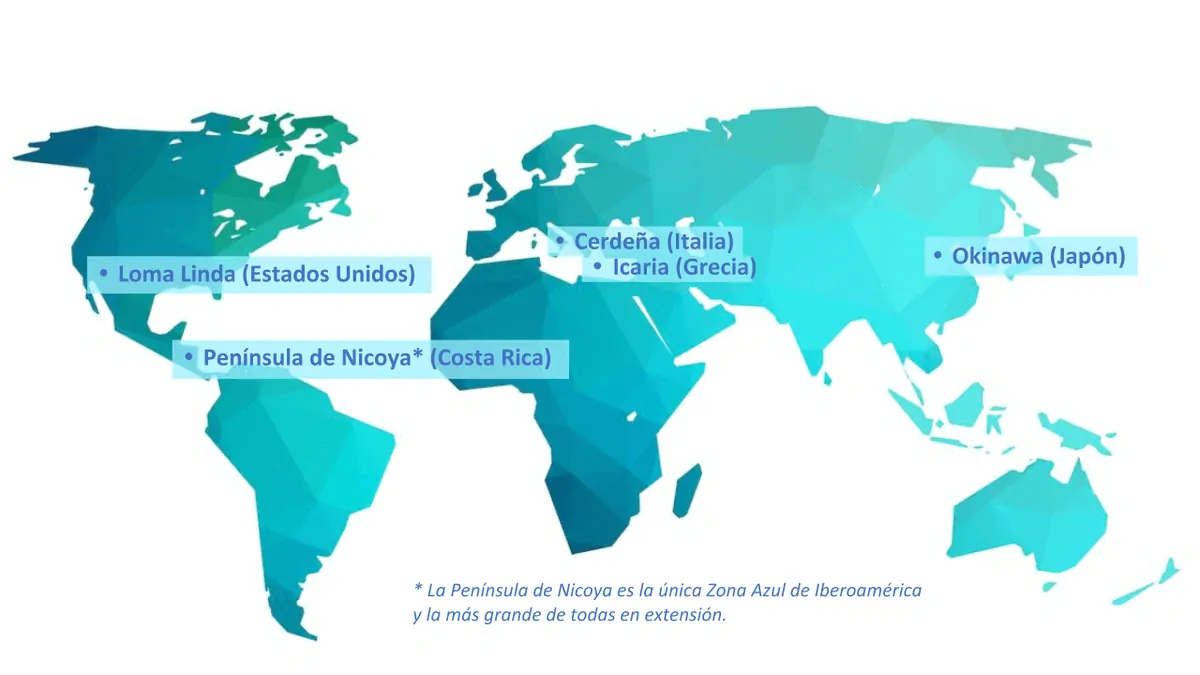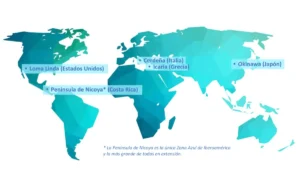Neuropsychologist Diana Carolina Gómez Blanco explains in this article what the blue zones (ZA) are and the secret of their inhabitants’ longevity, with special emphasis on the characteristics, keys and lifestyles of the populations of the ZA.
The blue zones and the secret of longevity
Since ancient times the search for eternal youth has captivated humanity, and many have looked for that magic formula that would increase years of life and overcome dreaded death. Even today there is that frenzied eagerness to stay young, and there are more and more diets, medical procedures and beauty articles that claim to stop the passage of time. However, what is a reality is that in the last 150 years, life expectancy has increased dramatically; more and more people reach old age.
“Longevity is increasing worldwide faster than many of us can imagine. In fact, demographers say the baby who will live to be 200 years old has already been born” (Figueroa Suarez et al., 2019, p.281). It is additionally noted that an unprecedented aging of the population in human history is occurring. And that, although cardiovascular mortality has decreased, mortality from diseases of the nervous system and from mental disorders has increased instead.

Taking this last point into account, the modern lifestyle, which mainly promotes sedentary behavior, as well as the inclusion of technologies that make life easier, both physically and cognitively, a diet based on processed foods high in sugars, sodium, calories and saturated fats, as well as a stressful pace of life, is causing this dream of long longevity to fail in terms of duration and quality. That said, there are some places in the world where this dream of great longevity seems to be fulfilled (Yáñez-Yáñez & Mc Ardle Draguicevic, 2021, p. 155).
Blue zones
In these zones people not only live longer, but they live better, where reaching an advanced age is not synonymous with disability; on the contrary, people reach very advanced ages with high levels of functioning. These areas have been called “blue zones.”
A blue zone (ZA) is a geographically bounded area where its population has an exceptionally high longevity, although this is not related to high economic income or specialized healthcare. These zones were initially called that because their first researchers used a blue marker to highlight them.
The following map indicates the blue zones detected so far.

That said, the longevity and life expectancy data in the ZAs are not conclusive at the moment, although they do show a higher proportion of centenarians, even compared to the most socially and economically developed countries.
Likewise, another difficulty in studying these populations is that they share genetic characteristics as well as lifestyle, so it is necessary to study more deeply the relationship with greater longevity. Clarifying that human aging is attributed to a mix of genetic and epigenetic factors, so it is important to pay attention to lifestyle factors that are easier to modify (Navarro-Pardo, 2015, p.79).
Variables of the blue zones (ZA)
Among the variables involved, it should be mentioned first that it is noted that only 20% of longevity is related to genetic factors, while 80% would be influenced by environment and lifestyles. Other authors suggest that this genetic factor accounts for between 25–30% of the variability in longevity.

Subscribe
to our
Newsletter
Characteristics of the blue zone populations by zone:
Therefore, the main characteristics that these populations have in particular are described below:
1. Icaria (Greece)
Populations in the blue zones have some habits and lifestyles that seem to influence their high longevity. Thus, for example, in Icaria, a Greek island of 255 km2, where its inhabitants are three times more likely to become centenarians than in most other places in the world, it also maintains a proportion ten times higher than the European average of people aged 90.
Morbidity
Regarding morbidity:
- the cancer incidence rate is less than 20%,
- cardiovascular diseases are 50% lower,
- there are no cases of depression,
- there are no cases of dementia.
Keys to longevity in Icaria (Greece)
A study has compiled possible keys to this longevity. Rodríguez – Pardo del Castillo & López Farré (2017, p.71- 72) note the following:
- A possible cause is the isolation that, due to its remoteness, allows the elderly to retain the same habits from half a century ago, such as walking the island’s steep mountains.
- Also highlighted is the Mediterranean diet; many of its centenarians say they only eat what they grow and catch, they do not eat meat. Some consider that having a glass of wine instead of water rejuvenates them. In a New York Times study, foods cooked with olive oil, the climate and the lack of stress may be the common cause of their secret. In addition to this Mediterranean diet, daily consumption of a mountain herb tea infusion such as sage, thyme, mint and chamomile is also attributed.
- A 30-minute nap a day, five times a week, reduces the probability of developing a cardiovascular disease by one third. Likewise, these islanders can sleep deeply for up to 10 hours.
- The mortality rate is nearly halved in those who maintain sexual relations at least twice a week after age 50.
- Exercise through physical activity in daily life, such as gardening, which encourages going out to water, weed and also harvest.
- In Icaria (Greece) they only use hand tools, make bread by hand, and travel on foot to the supermarket or work.
- Live deliberately and unhurriedly, the islanders live at a slow pace, without hurry; they take their time to observe and live, very similar to what occurs with meditation exercises.
2. Okinawa (Japan)
On the other hand, in Okinawa (Japan) not only is longevity notable, but low rates of arteriosclerosis, stomach cancer, as well as low risk of breast and prostate cancer have also been evidenced. Lower rates of Alzheimer’s have also been identified.
Diet in the Okinawa blue zone
Various authors have focused on eight elements regarding the diet of these inhabitants:
- Water: they consume between eight and twelve glasses daily.
- Infusions: specifically green tea and black tea; they usually drink them plain, without milk or sweeteners of any kind.
- Foods rich in calcium.
- Red meat and eggs once a week.
- Frequent consumption of soy.
- Fish: one to three servings a day, especially oily fish such as salmon or tuna.
- Three to five cups of rice, corn or pasta a day.
- Consumption of fruits and vegetables, preferably raw, especially carrots, cabbages, onions, peppers and seaweed.
Ikigai
In addition to this diet characterized by a low caloric intake, the elderly in Okinawa practice Ikigai, which refers to having a purpose in life, engage in physical exercise and tend to have family responsibilities. The elderly are welcomed by the family, to which Japanese spirituality is additionally added.
Moais
Friendship relationships, in groups called “moais”, are also highlighted, in which 5 committed friends support each other and foster the social environment.
Yuimaru
Okinawa is a very close-knit community, and “yuimaru” — which means a circle of relationships — is important; for example, they have family and community gardens.
All these activities, as well as fishing and other work, keep people active even at very advanced ages (90 years and older), taking into account that these activities are performed outdoors, which allows them to get sun exposure and thus synthesize vitamin D, which promotes bone strengthening.
Lifestyle factors that make Okinawa a blue zone
Finally, other lifestyle factors that seem to contribute to their great longevity have been identified:
- 80% of the elderly live alone, they are not dependent, as their health allows.
- They usually travel by bicycle or on foot.
- It is noteworthy that the DHEA hormone, a precursor of estrogen and testosterone, shows decreased levels.
- They get up very early and go to bed very early.
3. Loma Linda (California – USA)
Meanwhile, on the other side of the world in the Americas, the town of Loma Lina has one particular characteristic: more than half of its inhabitants are affiliated with the Seventh-day Adventist Church, and apparently belonging to this community seems to be the main factor that explains longevity.
For example, Saturday (Sabbath) is designated for rest and they do nothing that could be considered work. They also have social habits such as not smoking, not drinking alcohol and most of them do not eat meat; their diet is mainly composed of whole grains, fresh fruit and nuts; they do not consume caffeine or foods with saturated fats.
Religiosity is also notable, which is often attributed to between 4 and 14 extra years in life expectancy. It has been assessed that this factor helps modulate emotions by growing up with a higher purpose and therefore this emotional balance reduces stress situations.
It has been concluded that the inhabitants of Loma Linda die of the same diseases, but at much older ages, where residents exercise, go to bed early, live without alcohol and tobacco, and pray to God.
4. Nicoya (Costa Rica)
This peninsula is considered the largest longevity blue zone in the world, which contrasts with being an extremely poor area, with problems of malnutrition and hygiene.
A study conducted to evaluate the existence of a genetic factor that influences this found that Nicoyans lose more pairs of telomeres per year, but have length measurements almost similar to those who benefit from certain healthy habits such as exercising.
Additionally in Nicoya, some habits have also been identified such as consuming fresh, unprocessed foods, prioritizing rest and friendships, and including regular physical activity in their daily routine.
Their diet is mainly rich in whole foods, such as squash, corn, plantain, and a relatively low consumption of meat. Much of their food is harvested by themselves.
It has also been identified as a particular characteristic of this area that it has water rich in calcium, which results in lower rates of heart disease, stronger bones and fewer hip fractures.
5. Sardinia (Italy)
Finally, in this last blue zone, the key to its longevity is considered to lie in the Mediterranean diet, which features abundant consumption of olive oil, nuts, vegetables and fresh fruits.
Additionally, the isolation in which this population lives has fostered the emergence of genetic markers linked to longevity.
Likewise, many manual jobs are still preserved in this population, which in itself require physical effort even more exhausting than a gym session.
They are a community that maintains healthy relationships with those around them; no one lives alone, even if they reside without company at home. They remain independent, do their housework, walk to their neighbors’ homes, so their metabolism operates at a higher level.
Conclusion
Common characteristics of the blue zones
These five blue zones share the following characteristics that reinforce these healthy lifestyles and habits (Cavallini Solano et al., 2022, p. 99):
- everyday natural physical activity,
- sense of purpose,
- routines to combat stress,
- reduced intake, consumption of legumes,
- moderate alcohol consumption,
- membership in faith communities,
- dedication to family
- social support networks of family and community.
It is important to study these populations. Undoubtedly, they mark the milestones of what has been considered healthy aging and highlight those lifestyles that allow for a long life without it meaning disability, illness or loneliness.
These zonal areas are relevant in an increasingly aging population, in which the increase in neurological and dementing diseases is growing, and in which following lifestyle changes can effectively prevent their onset.
Bibliography
- Figueroa Suarez, J. A., Bravo Cevallos, D. M., & Guillen Mendoza, R. V. (2019). Salud, la esperanza y el coste de vida Health, hope and cost of living. Revista Arbitrada Interdisciplinaria de Ciencias de la Salud. SALUD Y VIDA, 3(6), 278-299. http://dx.doi.org/10.35381/s.v.v3i6.322
- Navarro-Pardo, E. (2015). ¿Por qué nos interesan las Zonas Azules? Conversas de Psicologia e do Envelhecimento Ativo, 77-91. ResearchGate. https://www.researchgate.net/publication/283625085_Por_que_nos_interesan_las_Zonas_Azules
- Rodriguez – Pardo del Castillo, J. M., & Lopéz Farré, A. (2017). Longevidad y envejecimiento en el tercer milenio: Nuevas Perspectives (1st ed.). Fundación Mapfre. https://www.escueladepensamiento.org/wp-content/uploads/2021/03/00000001_compressed.pdf
- Yáñez-Yáñez, R., & Mc Ardle Draguicevic, N. (2021). Zonas azules: longevidad poblacional, un anhelo de la sociedad. Rev Med Chile, (149), 147-158. https://www.scielo.cl/pdf/rmc/v149n1/0717-6163-rmc-149-01-0154.pdf
If you liked this article about the blue zones, you might also be interested in:
“This article has been translated. Link to the original article in Spanish:”
Las zonas azules y el secreto de la longevidad







 Surviving Neurons. The Importance of Early Neurorehabilitation in Stroke Cases
Surviving Neurons. The Importance of Early Neurorehabilitation in Stroke Cases
Leave a Reply